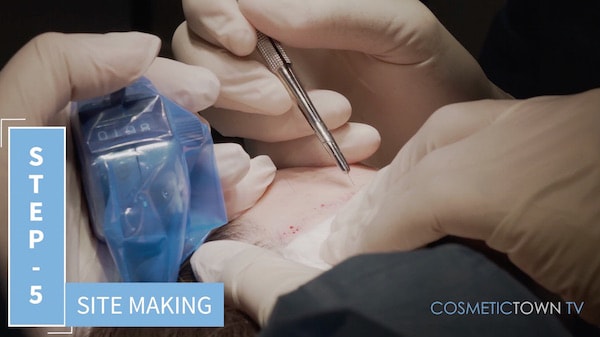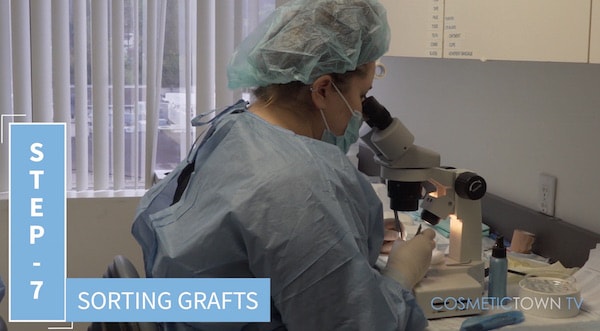FUE Hair Transplant – Everything You Need to Know

Recently, Dr. Mohebi was interviewed by Cosmetic Town to break down everything you need to know about one of the most popular hair restoration procedures: the FUE Hair Transplant. Enjoy the full interview and breakdown below!
What is an FUE Hair Transplant?
FUE stands for follicular unit extraction or follicular unit excision. This refers to when we go with a special device and try to remove follicular units one at a time without making a big cut or removing a big piece of the skin. This is so the grafts that we remove are barely bigger than the size of the follicular units themselves.
Who is the best candidate for an FUE procedure?
Anybody who is a good candidate for a hair transplant is a good candidate for FUE too. In fact, the FUE procedure can be an answer for people who are not good candidates for other types of hair restoration procedures. For example, in addition to the scalp hair, we can remove hair from the beard or any parts of the body, contrary to other types of hair transplants. So pretty much anywhere in your body that you have hair, we can go individually remove them and place them wherever we want.
How long do the results of FUE hair transplants last?
When done correctly, FUE hair transplant (just like other hair transplant procedures if the grafts are selected properly from the permanent zone) grafts are expected to stay for the rest of the patient’s life.
Advantages of FUE Hair Transplant
The advantage of doing a hair transplant via FUE method is that you don’t have to cut a piece of the skin. This means there’s no cutting involved, no suturing, stapling, no scar in the back and almost no pain or tightness after the procedure. The older method, hair transplants used to have to cut a strip of the skin out and we have to close them and people have a line of a scar that is permanent. And also there’s some tightness involved that people have to go through the next few days. FUE, however, induces almost no pain after the procedure and there’s no cutting or suturing or scaring.
Both men and women can get FUE hair transplants as long as they can have the preparation for the donor area that we have different methods of that be done.
Patient FUE Testimonial
“My procedure today went really well. Dr. Mohebi and I discussed a couple of things when I first got in. He took out a couple of devices and went over a few things on my hair and said, ‘This would be good for the future.’ Checked out where a good hairline would be, what would need to be done in order to keep it at its fullness. And then it was basically from there straight to the room and everything went good. No discomfort at all. The local anesthetic was great. I didn’t really feel any pain whatsoever. They were very cognizant if I did have any pain to go ahead and nip it in the bud and make it as comfortable as possible.” – Actual Patient
FUE Procedure Breakdown
Hairline Design

The first step of the procedure is to have the patient come into the office to design the hairline. We make sure that the hairline is something that’s appropriate for the patient’s sex, facial features, and age. These are all critical aspects for the hairline design. Designing the hairline is the artistic aspect of the procedure. If not done correctly, it will give a result that will show that this is transplanted hair rather than something that nobody can detect.
FUE Transplant Technology & Equipment

The device that we use for the extraction of grafts is called Trivellini System. The Trivellini System is a multiphasic device that goes through different layers of the skin with different modes. That way we can cut through the skin. For example, we start with rotation with maximum power and keep it at 300 milliseconds to allow the point to go to the skin.
Then we switch to oscillation. I use 240 degrees and for power, I use 80%. For the time I go, usually 400 sometimes 500 milliseconds. On the top, you see a smart react and on this side, we have this delay time. I set it up for 300 milliseconds that the system realizes that it has to start working after 300 milliseconds after I touch the skin. So smart react is the smart system that I let the system see where we have to start doing this.
Next, we start with rotation osculation we can add another mode. For this, I to use vibration, keeping my vibration on 60% for 200 milliseconds. The combination of rotation, oscillation, vibration will get me through different layers of the skin, cut the skin perfectly and keep the grafts in perfect shape.
Prepping Patients for FUE

When we take patients to the procedure room is the time that we have to prep patients for the procedure. We usually start with shaving on the donor area, but this depends on each individual procedure. We don’t always have to shave their heads because some people choose to go with the non-shaven method. In this case, we do shaving the donor area just as layer shaving. So we just shave one layer of the scalp on the back and the long hair is long enough to cover it so patients won’t miss anything. In the recipient area also we do shaving if we can. If patients are okay with that, especially people with long hair, they can comb the hair over and cover it. That being said, we usually prefer to shave it a little bit so we can be able to be more precise and dense pack the grafts into the recipient area better.

The next step is to administer the local anesthesia. When the patient is comfortable when the short-term sedation is onboard. It could be laughing gas or a shot that we gave them. People are comfortable with doing the local anesthesia. So basically even those little pricks that is involved with a little infiltration of local, we don’t want people to feel. At that point we are using a special fine needle and we go around the scalp and give them local anesthesia, it’s called ring block. That blocks all the nerves that brings the sensation to the scalp. By doing that, patients are not feeling anything throughout the process. We may need to repeat this process of locking infiltration of local anesthesia during the procedure too.

Site making is the next step that we are basically making small incisions that grafts will be placed into. So those incisions are very tiny. We were talking about 0.7 or 0.8 millimeter wounds that will be visible immediately after doing this. But then in a day or two it will be all healed and nobody can see any evidence of them. The depth of them are usually 4 to 4.5 millimeters. So those are teeny holes that we are making that eventually the grafts will be placed into. The reason we do it ahead of time is because we want to have the site, the design all done. So when we are extracting the grafts the technicians can start placing them into the premade sites.
Extraction & Placement

The next step is when we take patients to a different position and start extracting the grafts. We usually do this method it’s called simultaneous extraction and placement, meaning that when we extract the grafts, that technicians will place them into the pre-made sites.
So I start from one side, usually from the right side of the scalp and start extracting going towards the other side. As I’m extracting the grafts with this machine that extracts the grafts my technician follows me and removes them one at a time. Then those grafts are being handed to the counting team at the microscopic station.

Next step is counting and sorting the grafts under microscope. At this step, a technician will review every single grafts, make sure they are all intact. They will count them in terms of number of hair per graft and have them ready in the group of 20 grafts in a special solution to be removed and start the process of insertion or implantation.

Next step is the insertion of the grafts. At this step, we remove those grafts that are prepared under a microscope and we put them into the implanter. This device, it’s called Mohebi Implanter (Inserter), it is invented by Dr. Mohebi.
So this process is probably the longest process in the whole process of hair restoration because each has to be done under magnification, and the technicians have to find those small incisions that we already made and fill them with the grafts with Mohebi Implanter (Inserter).
Final Inspection

At the end of the process, we’re going to go and do a final inspection to make sure every hole that is supposed to be filled is done. I usually spend some time to go between the grafts. Some of the grafts may need to be rotated. Even the curvature of hair is very important to consider. It’s not just the angle distribution it’s also the curvature of the hair. They all have to be perfectly natural, the way that we see in nature. If I have to add density in certain areas, I’ll also do that. If I have to move some hairs from one area to another, I’ll do that because that’s the last step, that last opportunity that we have to make that hairline look perfect.
How does this procedure change people’s confidence?
It’s a big factor in people’s confidence. Hair restoration can increase people’s confidence and reduce anxiety. Social anxiety can have a major effect on people’s careers, sex lives, and levels of happiness. We’ve seen it on a regular basis in our offices, and if the hair restoration is done properly, it’ll bring back the patient, the look that they always had, or they always wanted. And with it, the patient’s confidence.